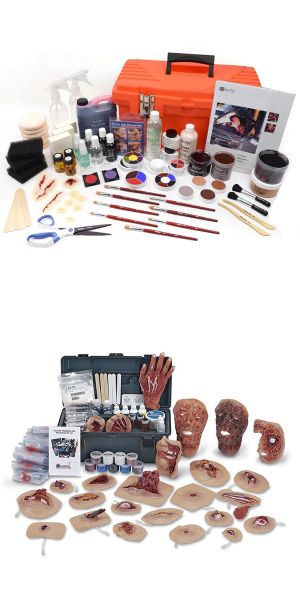Moulage
PAGE WARNING: Graphic images ahead. PAGE WARNING: Graphic images ahead. PAGE WARNING: Graphic images ahead.
From Wikipedia: "Moulage (French for 'casting, moulding') is the art of applying mock injuries for the purpose of training emergency response teams and other medical, military, or paramilitary personnel. Moulage may be as simple as applying pre-made rubber or latex "wounds" to a healthy patient's limbs, chest, head, etc., or as complex as using makeup and theatre techniques to provide elements of realism (such as blood, vomitus, open fractures, etc.) to the training simulation...
"...In modern terms, the word moulage refers to the use of "special effects makeup (SPFX) and casting or moulding techniques that replicate illnesses or wounds" in simulation based techniques. Common examples include designing diabetic wounds, creating burns or other illness effects, like dermatological rashes and gunshot wounds...
"...These illness and injury effects are applied to training manikins or simulated or standardized patients for training or other purposes. Simulation staff attend training to learn these techniques. It is argued that the use of moulage in simulation improves realism or participant buy-in. Moulage is an emerging field of research for paramedicine, radiography and medical education, with researchers exploring how moulage contributes to learning in training. Military training utilizes highly-authentic moulage techniques to desensitize to graphic wounds, prepare for battle, and treat injuries."
In Portland NET, moulage adds realism to exercises, desensitizes reactions to wounds, encourages decision-making during triage, and provides productive stress. PBEM and Portland NET does not have its own in-house moulage team. Cascadia Moulage, a Portland-area nonprofit organization, typically provides moulage services. NET volunteers often see moulage in exercises such as Scenario Village and Final Field Exercises. Volunteers wearing moulage are appropriately called Survivors, Survivor Actors, or Patients (PBEM used to describe them as "Victim Volunteers" or "VVs", but that is an outdated term).
Survivor Actor Preparations: General
If you are volunteering as a Survivor, thank you! Your presence as a Survivor will help save lives by increasing the level of realism for emergency responders. Exercises that offer the same stressors and lifelike elements are valuable in assisting responders when called upon in real emergencies.
This is also an excellent training opportunity for you. You will experience rescue and medical treatment from the patient's perspective, which will make you a better responder. For this reason, PBEM makes a shift as a Survivor part of the NET Task Book and creditable as Advanced Training for a NET's Minimum Service Contribution.
An important note: as a Survivor, you are encouraged to get moulaged but it is not usually required for participation. Not everyone is into getting made up, and that's OK.
